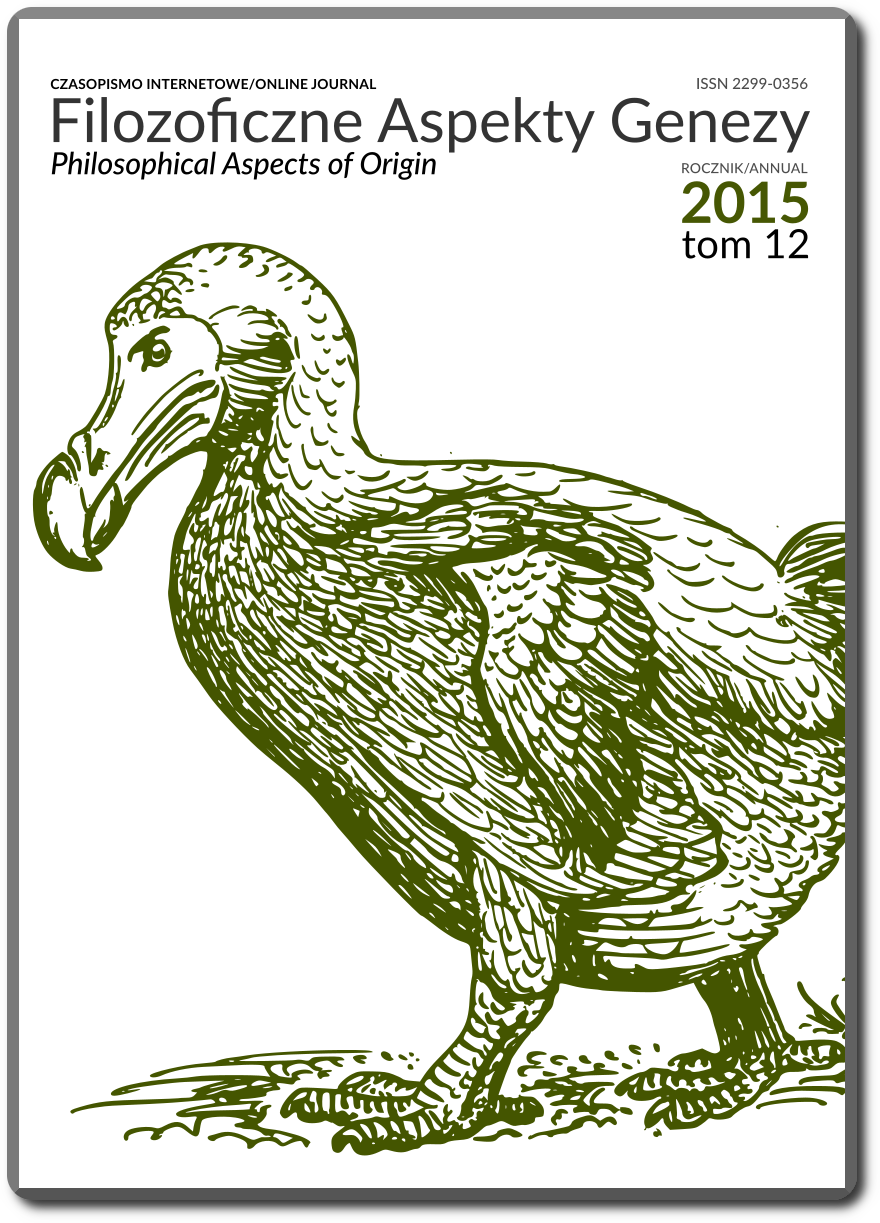Próba klasyfikacji "odmian" zwierząt w połączeniu z obserwacjami nietypowych zmian sezonowych i innych, które w sposób naturalny zachodzą u rozmaitych gatunków brytyjskich, lecz nie dają podstaw do wyodrębnienia odmian
Opublikowane 24.05.2015 — zaktualizowane 24.05.2021
Wersje
- 24.05.2021 - (2)
- 24.05.2015 - (1)
Słowa kluczowe
- odmiany prawdziwe,
- odmiany proste,
- odmiany nabyte,
- rasy,
- Opatrzność
- zmiana ubarwienia u zwierząt ...More

Utwór dostępny jest na licencji Creative Commons Uznanie autorstwa 4.0 Międzynarodowe.
Jak cytować
Abstrakt
Termin „odmiana” bardzo często jest niewłaściwie stosowany w odniesieniu do osobników danego gatunku, które przechodzą jedynie regularne, naturalne zmiany bądź w trakcie procesu dorastania, bądź stopniowo, w zgodzie z ustalonymi prawami, zmieniając swoje ubarwienie w danych porach roku. Zakładam, że dla niektórych czytelników pomocny będzie opis pewnych mniej powszechnie znanych zmian, które w naturalny sposób zachodzą u rozmaitych zwierząt brytyjskich. Niektóre z nich dotychczas pomijano, a inne opisywano niewłaściwie. Termin „odmiana” jest wykorzystywany w celu oznaczenia odchylenia od uznanego typu gatunkowego tak w budowie, rozmiarach, jak w ubarwieniu. Jest on jednak nieprecyzyjny, ponieważ używa się go na oznaczenie zarówno najdrobniejszych indywidualnych odmian, jak i najbardziej odmiennych ras, które wywodzą się ze wspólnego pnia. Ponadto termin ten jest wysoce nieodpowiedni w stosunku do zwierząt znajdujących się w jakimkolwiek stadium okresowych zmian naturalnych dla gatunku, do którego należą. Odmiany wymagają pewnej klasyfikacji. Proponuję podział odmian na cztery podstawowe grupy: odmiany proste, odmiany nabyte, rasy i odmiany prawdziwe. Druga część mojego artykułu dotyczyć będzie pewnych okresowych oraz innych zmian w wyglądzie zewnętrznym, które zachodzą w sposób naturalny u różnorodnych zwierząt brytyjskich, lecz nie dają podstaw do wyodrębnienia odmian. Wśród naszych rodzimych ssaków jestem w stanie wyróżnić trzy zasadnicze tryby zmiany ubarwienia, mianowicie: całkowite zrzucanie sierści, częściowe zrzucanie sierści oraz całkowita zmiana barwy samej sierści.
Downloads
Bibliografia
- Blyth Edward, „An Attempt to Classify the «Varieties» of Animals, with Observations on the Marked Seasonal and Other Changes which Naturally Take Place in Various British Species, and which Do Not Constitute Varieties”, The Magazine of Natural History, and Journal of Zoology, Botany, Mineralogy, Geology, and Meteorology 1835, vol. VIII, s. 40-53.
- Eiseley Loren, „Charles Darwin, Edward Blyth, and the Theory of Natural Selection”, Proceedings of the American Philosophical Society 1959, vol. 103, no. 1, s. 94-158.
- List Lansdowna Guildinga z 1 maja 1830 roku, The Magazine of Natural History 1834, vol. VII.
- Herald Morning 1825 (4 lipca, 29 sierpnia), The Magazine of Natural History 1834, vol. VII.
- Mercury Tyne . Bury and Suffolk Post 1833 (26 czerwca), The Magazine of Natural History 1834, vol. VII.
- List Jamesa Fennella z 11 lipca 1833 roku, The Magazine of Natural History 1834, vol. VII.
- List Henry’ego Berry’ego z 27 sierpnia 1834 roku, The Magazine of Natural History 1834, vol. VII.
- List A. Clifforda z 13 grudnia 1833 roku, The Magazine of Natural History 1834, vol. VII.
- List W.T. Bree z 8 października 1834 roku, The Magazine of Natural History 1834, vol. VII.
- List S.D.W. z września 1834 roku, The Magazine of Natural History 1834, vol. VII.
- Montagu in Rennie’s Mont, Orn. Dict, The Magazine of Natural History 1834, vol. VII.
- List Henry’ego Turnera z 1 marca 1833 roku, The Magazine of Natural History 1834, vol. VII.
- List Thomasa Weatherilla z 7 grudnia 1833 roku, The Magazine of Natural History 1834, vol. VII.
- List E.W.S. z 20 marca (brak informacji o roku), The Magazine of Natural History 1829, vol. I, s. 66.
- List W.T. Bree z 23 maja 1828 roku, The Magazine of Natural History 1829, vol. I, s. 178-179.
- Lawrence William, Lectures on Physiology, Zoology, and the Natural History of Man, Delivered at the Royal College of Surgeons, J. Callow, London 1819.
- Partington Charles Frederick (ed.), The British Cyclopaedia of Natural History: Combining a Scientific Classification of Animals, Plants, and Minerals: With a Popular View of Their Habits, Economy, and Structure, vol. 1, Orr & Smith, London 1835, s. 219-222.
- Home Everard, „Experiments and Observations on the Growth of Bones, from the Papers of the Late Mr. Hunter”, w: John HUNTER, Observations on Certain Parts of the Animal Oeconomy, Inclusive of Several Papers from The Philosophical Transactions, etc., Longman, Orme, Brown, Green, and Longmans, London 1837, s. 315-318.
- Home Everard, „Experiments and Observations on the Growth of Bones, from the Papers of the Late Mr. Hunter”, Transactions of a Society for the Improvement of Medical and Chirurgical Knowledge 1800, vol. 2.
- List H.S. z 4 kwietnia 1828 roku, w: The Magazine of Natural History 1829, vol. I, s. 378.
- W.H.H.: Stempel pocztowy, Burton on Trent, 8 października 1834.
- Guilding Lansdown, St. Vincent, 1 maja 1830.
- dr Stark, „On the Influence of Colour on Heat and Odours”, w: The Edinburgh New Philosophical Journal lipiec 1834.
- Prichard James Cowles, Researches into the Physical History of Man, J. and A. Arch, London 1813.
- Lyell Charles, Principles of Geology, vol. 2, John Murray, London 1832.
- The Magazine of Natural History 1833, vol. VI, s. 79.
- Bowman J.E., „Changes in the Colour of the Coverings of Animals towards Winter”, The Magazine of Natural History 1833, vol. VI, s. 79-81.
- Mudie Robert, Feathered Tribes of the British Islands, vol. 1, Whittaker and Co., London 1834.
- Blyth Edward, „A Few Remarks on Hybrids, in Reference to Mr. Berry’s Communication in VII. 599”, The Magazine of Natural History, and Journal of Zoology, Botany, Mineralogy, Geology, and Meteorology 1835, vol. VIII, s. 198-201.
- Blyth Edward, „Observations on the Cuckoo”, The Magazine of Natural History, and Journal of Zoology, Botany, Mineralogy, Geology, and Meteorology 1835, vol. VIII, s. 325-340.
- Blyth Edward, „A Notice of a Very Remarkable Individual of the Common Shrike (Lànius Collừrio Lin.), with some Observations on this Species of Shrike”, The Magazine of Natural History, and Journal of Zoology, Botany, Mineralogy, Geology, and Meteorology 1835, vol. VIII, s. 364-371.



